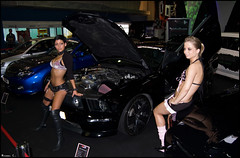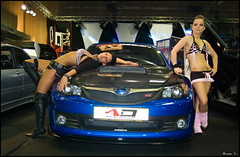
Over its 61-year history, Lotus Cars has spent a considerable amount of time clawing its way back from the brink of insolvency. The company's most recent bout with financial disrepair came in the early Nineties after the front-wheel-drive Elan proved a commercial failure (surprise!) and the Esprit toiled away in the shadows of newer, more powerful supercars. As hope for the historic marque's triumphant return began to fade, a group of Lotus engineers pooled their collective will to create an all-new, back-to-basics model that would revive Colin Chapman's company and give hardened enthusiasts the purist's driving tool they craved.
In September of 1996, the Elise was born, and four years later, its hard-top sibling – the Exige – came on the scene. Over the last decade, we've seen a raft of super-special-limited-edition variants follow in its lightweight wake, but the ultimate version is this: the 2009 Lotus Exige S 260. Packing more power and "more lightness" than the 240 Sport we sampled last year, there's no doubt it's a telepathic terror on track, but we wanted to know if it was up to the depravity of Michigan roads, so we set our chiropractor on speed dial and headed out...
But first, a quick recap of high school physics.
The definition of kinetic energy is e = 1/2 * m * v2. You can rearranged that equation to v = square root ((2 * e) / m). Automotive translation? You can make a vehicle quicker by either increasing available energy (more power!) or by cutting its mass (more lightness!). With this latest Exige, Lotus engineers have clearly said: "Screw it. Let's do both." And with that, they've taken the 240 S – already one of the lightest street cars on the market – and shaved nearly 60 pounds by replacing the engine cover, rear wing, front splitter, roof and side ducts with carbon fiber pieces, and they've fitted a set of lightweight sports seats and plonked a minimalist battery in the "trunk."

With the weight reduction out of the way, the engine tweakers in Hethel extracted a further 17 horsepower out of the supercharged, 1.8-liter Toyota-sourced four-cylinder engine to bring total output up to 257 horsepower and torque to a reasonably stout 174 pound-feet. While that's nothing to write home about in the two-ton luxobarges that populate the Great Lakes State, fit it to something that weighs just over 2,000 pounds while meeting the Fed's safety standards – all while returning 20 mpg in the city and 26 mpg on the highway – and you've got one of the most potent performance creations available to man. Assuming you can fit inside.
Lotus manages to achieve such a low mass (while meeting modern regulatory standards) by using a novel architecture built from a collection of aluminum extrusions riveted and glued together. The issue of ingress and egress stems from this: the chassis was originally designed for a convertible. The side beams are large enough to support most of the structure, meaning they're both tall and wide. In an Elise sans roof, no big deal. You just step over the sill and plop your backside into the seat. With the roof bolted in place, the experience is closer to sliding through the window of a race car or, more appropriately, down the barrel of a cannon.


Once you've wiggled your way inside (helpful hint: place your right foot in the well, sit on the sill, grab the wheel and tug yourself through), you're ensconced in a carbon fiber shell with a minimal amount of padding. The driver's seat moves fore and aft (the passenger seat is fixed) and both thrones benefit from cut-outs to accommodate a five-point racing harness and HANS device. As the seats are solid pieces of carbon fiber, there's no lateral give, so you'll want to start shopping for diet books on Amazon... yesterday.
The Exige's diminutive size and cramped cabin causes your legs to cant towards the center of the car where the trifecta of proper pedals reside, and while the steering wheel is fixed, the upright seats allow the wheel and shifter to fall readily to hand. Although early Elises were bereft of carpeting, exposing the matte aluminum to reaffirm your hardcore surroundings, the Exige receives carbon fiber caps on the door sills and dashboard, while the steering wheel, door panels and center console are coated in Alcantara. Cubbies? All you've got is an aluminum tray to the right of the radio and (hopefully) a helpful passenger.




Starting up the Exige involves pressing the unlock button on the key, inserting it into the column, twisting it to the "On" position and – within 30 seconds – pressing the engine "Start" button on the left side of the dash. If you miss the 30 second window, you simply press the button on the fob and the four-pot behind your head spins to life.
Historically, Toyota's high output, variable valve timing-equipped 1.8-liter four is too high strung and lacks usable grunt near the bottom of the tach. Fortunately, the supercharger Lotus has fitted to the Exige addresses both issues, removing the torque deficit and vastly improving daily drivablity. Combined with the Exige's low mass, the engine makes trolling along in stop-and-start traffic a remarkably effortless process. The trade-off? With the intercooler mounted atop the engine and fed by the roof-mounted scoop, the rear window has been replaced by a solid bulkhead, leaving the outside mirrors as the only means of conveying what's going on behind you. Combined with the oh-so-low roof and seating position, road monsters like the Honda Fit tower over the Exige. Those afflicted with Napoleon complexes need not apply.




Naturally, maneuvering around a garage or parking lot takes some effort as the Exige – like its predecessors – doesn't come equipped with power assisted steering. However, once you're on the go, the effort falls away and the helm is pure mechanical perfection. Once you escape the confines of urban life, any worries about size, steering or visibility simply melt into the distance.
Climbing up the Exige's graduated tachometer towards 9,000 RPM, you'll notice there's no marked redline. Instead, a series of three red LEDs illuminate on the dash when it's time to shift. When the engine is cold, the indicators come on between 5,000 and 6,000 RPM. Once the coolant and oil are up to temperature, you can throttle down, spin the 2ZZ past 4,000 RPM – where the VVTi kicks in – all the way to its 8,500 RPM redline and enjoy the mechanical duet of the engine and supercharger ricocheting around the undampened cabin.
With the engine rocketing towards redline, the Exige's gearbox is ready to deliver six perfectly spaced ratios to keep the supercharged four in its meaty sweet spot. The aluminum shift lever benefits from short throws, although the linkage on our (likely abused) press car could have been slightly more precise. The narrow footwell – a minor annoyance earlier – became an asset, with closely spaced pedals that made heel-and-toe action a breeze.




Off the line, the Exige has you covered with a variable launch control feature. Unlike most systems that give you one option to create the perfect standing start, Lotus allows drivers to set the engine's launch control speed anywhere between 2,000 and 8,000 RPM via a knob on the left of the steering wheel. Once it's set, simply floor the long pedal and the system holds the engine at the pre-set speed. Drop the clutch and you've got a perfect launch time after time. After fiddling with the settings, we found the magic mark (4,500 RPM), allowing the Exige to burst off the line with the perfect amount of wheel spin. No bogging, no slithering, just thrust – even on less-than-perfect surfaces.
But as good as the engine, launch control and auditory assault are, they're far from the best part.
It's no wonder automakers around the world tap Lotus Engineering to sort out their suspensions – the Exige is the perfect case study. Simply put, the roads in southeast Michigan suck. They're loaded with bumps, cracks and heaves. But even though the Exige is clearly not tuned for comfort, the suspension does a remarkable job of dealing with Michigan's worst.
Unlike most stiffly sprung sports cars, the Exige doesn't bounce around. The copious quantities of mechanical grip convey every nuance of the tarmac into the cabin, but none of this is as jarring as you'd expect. Flying down a curvy road at a clip far beyond what most cars are capable of, your backside just inches from the road, the Exige is supremely confidence inspiring. Even hitting a frost heave mid-corner left our little Lotus unperturbed.

Unfortunately, it's not always sunshine and sweeping tarmac. But even at those times, the Exige impressed. Cruising down the freeway in a downpour, the window defogger did an admirable job of maintaining forward visibility – and even with the nearly slick Yokohama Advan A048s fitted at all four corners, the Exige never slipped or slithered. While it's far from a daily schlepper – a four cubic foot bin behind the engine bay and whatever space you can manage in the passenger seat is what passes for cargo space – as a play thing, the S 260 approaches four-wheeled perfection.
Another benefit of the Exige's small engine and featherweight design is decent fuel economy. The EPA rates the Exige S260 at 20/26 mpg city and highway and we averaged 19 mpg on two fill ups of the 10.6 gallon tank. The Exige and its carbon fiber doesn't come cheap though. The S 260 adds $9,000 to the starting price of the S240 and the out-the-door tab affixed to our example came to $77,115. That's more than $30,000 less than a Tesla Roadster, which shares its lineage with the Lotus Elise. Given that most drivers of either this or the Tesla are likely to put on far fewer miles than on an average car, we'd opt for the 2-3 minute fill ups of the Lotus if it were our own money – assuming, of course, that we wedge ourselves inside.
[Source: Autoblog]













































